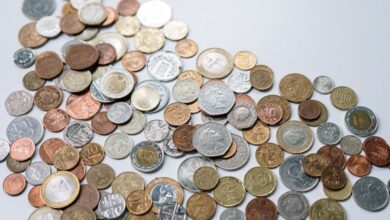Metals in Motion: Analyzing Silver, Copper, and Rare Earths in Today’s Economic Landscape

In an increasingly interconnected global economy, the dynamics of metal markets play a crucial role in shaping both industrial growth and investment strategies. This article delves into the multifaceted world of metals, examining how their value and demand are influenced by technological advancements, economic indicators, and regulatory frameworks. From silver's unique position as both an industrial staple and a favored investment asset, to copper's role as a reliable barometer of economic health, each metal tells a story that reflects broader market trends. Furthermore, as green energy technologies accelerate the demand for rare earth metals, the competition between platinum and palladium intensifies, prompting investors to weigh their options carefully. Amidst rising inflation, the strategic use of metals for portfolio diversification has become more relevant than ever, while the future of aluminum in a sustainable economy beckons new opportunities. This exploration will also highlight how mining regulations can significantly impact metal prices, providing a comprehensive overview of the intricate relationships that define the modern metal market. Join us as we navigate these critical themes and uncover the pivotal role that metals play in both industrial applications and investment portfolios.
- 1. "Silver: A Dual Force in Industry and Investment Landscapes"
- 2. "Copper Prices: Barometer of Global Economic Well-Being"
- 3. "Navigating the Green Revolution: Rare Earth Metals in High Demand"
1. "Silver: A Dual Force in Industry and Investment Landscapes"
Silver plays a unique and multifaceted role in both industrial applications and investment strategies, making it a dual force in today's economic landscape. On the industrial side, silver is renowned for its exceptional conductivity, thermal properties, and antibacterial qualities. These characteristics make it indispensable in various sectors, including electronics, solar energy, and healthcare. The rise of green technologies, particularly solar panels, has significantly boosted demand for silver, as it is a critical component in photovoltaic cells. Additionally, the growing emphasis on electric vehicles and advanced battery technologies further enhances silver's industrial relevance.
In the investment realm, silver is often viewed as a safe-haven asset, similar to gold. Investors turn to silver during periods of economic uncertainty or inflation, as it tends to maintain its value and can act as a hedge against currency devaluation. The increasing interest in precious metals as a means of portfolio diversification has led to a resurgence in silver investment, with options ranging from physical bullion to exchange-traded funds (ETFs). Moreover, the silver market is influenced by both speculative trading and the physical demand from industries, creating a dynamic interplay that can lead to price volatility.
This duality of silver as both an industrial commodity and an investment asset underscores its significance in global markets. As industries evolve and economic conditions fluctuate, silver's role is likely to adapt, making it an essential element for investors and manufacturers alike. The ongoing developments in technology and economic policies will continue to shape the future of silver, reinforcing its position as a critical player in both the industrial and investment landscapes.
2. "Copper Prices: Barometer of Global Economic Well-Being"
Copper prices have long been considered a key indicator of global economic health, often referred to as "Dr. Copper" due to its ability to reflect the state of economic activity. This metal is widely used across various industries, including construction, electronics, and manufacturing, making it a critical component in assessing economic trends. When economies are thriving, demand for copper typically increases, driving prices upward. Conversely, during economic downturns, demand tends to wane, leading to lower prices.
The relationship between copper prices and economic health can be attributed to several factors. Infrastructure development, for example, relies heavily on copper for wiring and plumbing, meaning that increased spending in this sector signals economic growth. Additionally, the manufacturing sector's performance directly impacts copper demand; as production ramps up during periods of economic expansion, so too does the need for this versatile metal.
Global events also play a significant role in influencing copper prices. For instance, geopolitical tensions, trade policies, and changes in consumer behavior can create volatility in the copper market. The emergence of major players, particularly in countries like China, further complicates the dynamics. As one of the largest consumers of copper, fluctuations in China's economic activity can drastically affect global copper prices, making it essential for investors to monitor developments in this region.
Moreover, the transition to renewable energy technologies is poised to reshape copper demand in the coming years. Electric vehicles, solar panels, and other green technologies require substantial amounts of copper, suggesting that as the world moves toward sustainability, copper could see sustained demand growth. This shift not only reinforces copper's status as a barometer of economic health but also underscores its critical role in the evolving landscape of global industries.
In summary, copper prices serve as a reliable indicator of global economic well-being, reflecting the interplay of demand across various sectors. Investors and economic analysts alike closely monitor these prices to gauge economic trends and make informed decisions.
3. "Navigating the Green Revolution: Rare Earth Metals in High Demand"
The transition to green energy technologies has significantly increased the demand for rare earth metals, which are essential components in a variety of applications, including electric vehicles (EVs), wind turbines, solar panels, and battery storage systems. These metals, which include elements like neodymium, dysprosium, and lanthanum, are critical for the production of high-performance magnets, phosphors, and catalysts that enhance the efficiency and effectiveness of renewable energy technologies.
As governments and industries worldwide commit to reducing carbon emissions and investing in sustainable energy sources, the demand for rare earth metals is expected to grow. For instance, the surge in EV production necessitates large quantities of neodymium for powerful electric motors, while the construction of wind farms relies heavily on rare earth elements for efficient turbine design. This rising demand is driving up prices and prompting nations to explore domestic sources of these metals, reducing reliance on traditional suppliers like China, which currently dominates the market.
However, the extraction and processing of rare earth metals pose significant environmental and geopolitical challenges. Mining practices can lead to severe ecological damage, and the concentration of production in a few countries raises concerns about supply chain vulnerabilities. As a result, companies and governments are increasingly focused on developing sustainable mining practices and recycling technologies to recover rare earth metals from old electronics and other waste.
In summary, the green revolution is not only reshaping energy production but also intensifying the global competition for rare earth metals. This dynamic is influencing market strategies and investment decisions, as stakeholders seek to capitalize on the growing importance of these materials in achieving a sustainable future.
In conclusion, the intricate landscape of metal markets reveals a dynamic interplay between industrial demand, investment strategies, and global economic trends. Silver stands out as a vital player, fulfilling both industrial applications and investment roles, while copper prices serve as a critical barometer for assessing global economic health. As we navigate the green revolution, the burgeoning demand for rare earth metals underscores the transformative shift towards sustainable technologies, highlighting their essential role in modern innovation.
The comparative analysis of platinum and palladium illustrates the nuanced considerations investors must weigh when diversifying their portfolios, particularly in the face of inflationary pressures that impact the prices of both precious and industrial metals. Additionally, the future of aluminum in a sustainable economy points towards opportunities for growth and adaptation in an increasingly eco-conscious market.
Finally, the influence of mining regulations on metal prices emphasizes the need for a balanced approach that supports both environmental stewardship and economic viability. As we look ahead, understanding these multifaceted relationships will be crucial for investors and industries alike, ensuring informed decisions in an ever-evolving market landscape.





